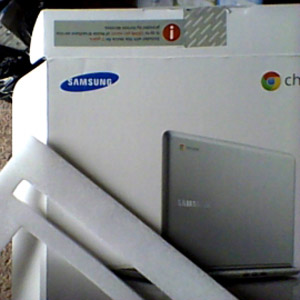 NEWS
NEWS
 NEWS
NEWS
 NEWS
NEWS
![]() It’s a rainy day and Fedex says that the Samsung Chromebook is on the truck–out for delivery. For me, it’s like any other day as I wait and do general work at the computer. The tasks are simple: play a few games, read everything in my Google Reader feed, retweet a few messages on Twitter, and finally distill my thoughts about everything I’d done onto the keyboard.
It’s a rainy day and Fedex says that the Samsung Chromebook is on the truck–out for delivery. For me, it’s like any other day as I wait and do general work at the computer. The tasks are simple: play a few games, read everything in my Google Reader feed, retweet a few messages on Twitter, and finally distill my thoughts about everything I’d done onto the keyboard.
The rain smells sweet, so I open the window to let the scent in, it has the secondary use of amplifying every sound from the front of the house. When the driver finally arrives at around 5pm–I live out in the boonies compared to the truck site–I can hear the squeak of the gate as he opens it.
The rain has abated for a few minutes, but the ground is wet beneath his feet as he stands on my stoop. Our transaction is quick, a few words verifying that I’m the Kyt Dotson on the package, and I sign my name–illegibly–on his electronic reader to signify that I’d received the box. It’s light in my hands, a boring-old-brown-box that I carry into the kitchen to split open with a knife.
Inside is a glossy, white box with a Samsung logo and the word “CHROMEBOOK” beneath. (I took the picture for this article with the Chromebook camera app itself, uploaded the image to Google Docs, and attached it to this article in the office.)
This is the shipping Matryoshka ritual that everyone who receives packages such as this goes through each time. Each new box smaller than the first, and in the end the Chromebook feels much smaller in my hands than I expect.
It’s about the size of a sheet of paper and as thick as a “getting started” computer manual. I am at first taken aback by how tiny it feels in my large hands as I roll it over in my grip. I’m a PC person, my laptops are hefty monsters designed to be desktop replacements–in my hands, the Chromebook feels almost insubstantial. According to the specs its less than an inch in width and about 2.5 pounds; a fluttering bird beneath my fingertips compared to the beasts that I’m used to.
Going through the other components of the box, I discover a bag with a Quick Start Guide, a warranty card, a safety precautions manual, even a nice slip of paper outlining the basic features. The best part? A huge Chrome button with a barcode on the back. It ends up on the top of the pile along with my curiosity.
Next is the power brick and a cable to plug it into the wall. The Chromebook battery comes uncharged “for safety reasons during shipping” so I’ll have to plug it in before I can get started. The adapter power plug is very small, fitting for such a tiny device, and it slots into the back.
As per-usual with a new device, I get it plugged in and charging before I get going with anything else.
Like a good consumer, at this point I should be reading the “Quick Start Guide” but I’m impatient and I just get the tiny, silver laptop opened and I’m already hitting the power button.
Next up: Getting started with the Chromebook set up and the UI.
Part 1: The Unboxing | Part 2: The Setup | Part 3: The Apps | Part 4: Entertainment
The device used for this review is the 3G version of the Samsung Chromebook (XE303C12-H01US), 11.6” screen, 1.7 GHz Exynos 5200 processor, 2 GB DDR3L SDRAM, and 16 GB Flash harddrive. Over the extent of the review, I updated the Google Chrome OS once and wrote the entirety of the review series using the Chromebook and the available apps on the device itself.
Support our mission to keep content open and free by engaging with theCUBE community. Join theCUBE’s Alumni Trust Network, where technology leaders connect, share intelligence and create opportunities.
Founded by tech visionaries John Furrier and Dave Vellante, SiliconANGLE Media has built a dynamic ecosystem of industry-leading digital media brands that reach 15+ million elite tech professionals. Our new proprietary theCUBE AI Video Cloud is breaking ground in audience interaction, leveraging theCUBEai.com neural network to help technology companies make data-driven decisions and stay at the forefront of industry conversations.